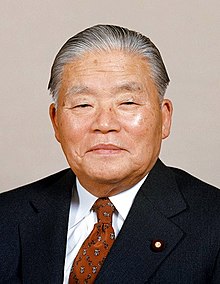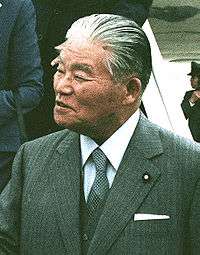Masayoshi Ōhira
Masayoshi Ōhira (大平 正芳, Ōhira Masayoshi, 12 March 1910 – 12 June 1980) was a Japanese politician who was Prime Minister of Japan from 1978 to 1980. Ōhira's time in office was cut short when he died in office; he remains the most recent Japanese Prime Minister to die in office (Keizō Obuchi was removed from office on 5 April 2000 after suddenly falling into a coma, a month before his death in May 2000).
Masayoshi Ōhira | |
|---|---|
大平 正芳 | |
 | |
| Prime Minister of Japan | |
| In office 7 December 1978 – 12 June 1980 | |
| Monarch | Shōwa |
| Preceded by | Takeo Fukuda |
| Succeeded by | Masayoshi Itō |
| Minister of Finance | |
| In office 16 July 1974 – 24 December 1976 | |
| Prime Minister | Kakuei Tanaka Takeo Miki |
| Preceded by | Takeo Fukuda |
| Succeeded by | Hideo Bo |
| Minister for Foreign Affairs | |
| In office 7 July 1972 – 16 July 1974 | |
| Prime Minister | Kakuei Tanaka |
| Preceded by | Takeo Fukuda |
| Succeeded by | Toshio Kimura |
| Minister of International Trade and Industry | |
| In office 30 November 1968 – 14 January 1970 | |
| Prime Minister | Eisaku Satō |
| Preceded by | Etsusaburo Shiina |
| Succeeded by | Kiichi Miyazawa |
| Minister for Foreign Affairs | |
| In office 18 July 1962 – 18 July 1964 | |
| Prime Minister | Hayato Ikeda |
| Preceded by | Zentaro Kosaka |
| Succeeded by | Etsusaburo Shiina |
| Chief Cabinet Secretary | |
| In office 19 July 1960 – 18 July 1962 | |
| Prime Minister | Hayato Ikeda |
| Preceded by | Etsusaburo Shiina |
| Succeeded by | Yasumi Kurogane |
| Member of the House of Representatives | |
| In office 1 October 1952 – 12 June 1980 | |
| Personal details | |
| Born | 12 March 1910[1] Kan'onji, Japan |
| Died | 12 June 1980 (aged 70) Minato, Japan |
| Political party | Liberal Democratic |
| Spouse(s) | Shigeko (1916–1990) |
| Children | 4 |
| Alma mater | Hitotsubashi University |
| Signature |  |
He was born in present-day Kan'onji, Kagawa and attended Hitotsubashi University.
Political career


At the apex of his political life, Ōhira came to represent what were known as "mainstream factions" within the Liberal Democratic Party (LDP) which put him at odds with Prime Minister Takeo Fukuda, who led what were known as an "anti-mainstream" faction.[2] Ōhira served as foreign minister in the cabinet of Kakuei Tanaka until mid-July 1974.[3] In a cabinet reshuffle in July 1974, he was replaced by Toshio Kimura as foreign minister and then appointed the finance minister, replacing Takeo Fukuda.[3]
Ōhira was elected to the presidency of the LDP in late 1978. On 7 December 1978, he was appointed 68th Prime Minister, successfully pushing Takeo Fukuda from his position.[4]
Ōhira was the sixth Christian to hold this office after Hara Takashi, Takahashi Korekiyo, Ichirō Hatoyama, Tetsu Katayama, and Shigeru Yoshida.
In the general election of 1979, the LDP narrowly failed to win an outright majority, but enough independent members of the Diet joined the party to enable Ōhira to remain in office, and he was duly reappointed on 9 November of that year. On 16 May 1980, a vote of no confidence was held in the Diet.
Ōhira expected the motion to fail, and was visibly shaken when it passed 243–187. 69 members of his own LDP, including Fukuda, abstained. Given the choice of resigning or calling new elections, Ōhira chose the latter and began campaigning for LDP candidates. He was hospitalized for exhaustion on 31 May and died of a massive heart attack 12 days later.
Chief Cabinet Secretary Masayoshi Ito acted in Ōhira's place as deputy after his death. Yoshio Sakurauchi, the Secretary General of LDP, led the LDP to its greatest victory in fifteen years, capitalizing on the "sympathy vote" generated by Ōhira's death. The Prime Minister was succeeded by Zenkō Suzuki after the election.
G7 summit
In 1979, Ōhira was the chairman and host of the 5th G7 summit in Tokyo but his fatal heart attack on 12 June happened only days before the 6th G7 summit was about to begin in Italy. Ōhira's colleague, Foreign Affairs Minister Saburo Okita, led the delegation which represented Japan in his place. Others joining Okita in traveling to the Venetian island of San Giorgio Maggiore were Finance Minister Noboru Takeshita and the head of the Ministry of International Trade and Industry.[5]
Personal life
Religion
Ōhira converted to Christianity during his time at the Takamatsu Higher School of Commerce (now the Takamatsu College of Economics), though without becoming a member of any formal Christian organization.[6][7] However, others have stated that he was a member of the Anglican Church during the 1970s.[8]
Honours
- Grand Cordon of the Order of the Chrysanthemum (12 June 1980; posthumous)[9]
- Golden Pheasant Award of the Scout Association of Japan (1980)[10]
- In Mexico City, Mexico, a park was named after him; it is located south of Rio Churubusco avenue and East of Tlalpan avenue.
Foreign honours
.svg.png)


References
- "Man in the News". The New York Times. 1 September 1972. Retrieved 5 January 2020.
- Nihon Kōgyō Shinbunsha. (1979). Business Japan. Vol. 24, Nos. 10–12, p. 47.
- "Tanaka reshuffles Japanese cabinet". Daytona Beach Morning. Tokyo. AP. 17 July 1974. Retrieved 6 January 2013.
- Brown, James Robert. (1999). The ministry of finance, p. 199.
- Stokes, Henry Scott. "Japan's Prime Minister Ōhira Dies At 70 as a Critical Election Nears; Japan's Prime Minister Dies at 70 After Heart Attack Plans for Venice Meeting", The New York Times. 12 June 1980.
- Choy, Lee Khoon (1995). Japan — Between Myth and Reality. Singapore: World Scientific Publishing Co. Pte. Ltd. p. 109. ISBN 981-02-1865-6. Retrieved 15 July 2019.
- Rothacher, Albrecht (1993). The Japanese Power Elite. Macmillan Press Ltd. p. 87. ISBN 978-1-349-22995-6. Retrieved 15 July 2019.
Ohira as a University student later joined the 'no-church movement' and has treated his religious convictions as a private matter ever since.
- Ikehara, Mariko (2011). Doak, Kevin M. (ed.). Xavier's Legacies: Catholicism in Modern Japanese Culture. Vancouver, Canada: UBC Press. p. 108. ISBN 978-0-7748-2022-6. Retrieved 15 July 2019.
- From the corresponding article in the Japanese Wikipedia
- http://reinanzaka-sc.o.oo7.jp/kiroku/documents/20140523-3-kiji-list.pdf
- "Semakan Penerima Darjah Kebesaran, Bintang dan Pingat".
Bibliography
- Brown, James Robert. (1999). The ministry of finance: bureaucratic practices and the transformation of the Japanese economy. Westport, Connecticut: Greenwood Publishing. ISBN 978-1-56720-230-4; OCLC 39033542
- Satō, Seizaburō Ken'ichi Kōyama and Shunpei Kumon. (1990). [Postwar Politician: The Life of Former Prime Minister Masayoshi Ohira.] Tokyo: Kodansha. ISBN 978-4-7700-1499-3
| Political offices | ||
|---|---|---|
| Preceded by Etsusaburo Shiina |
Chief Cabinet Secretary 1960–1962 |
Succeeded by Yasumi Kurogane |
| Preceded by Zentaro Kosaka |
Minister of Foreign Affairs 1962–1964 |
Succeeded by Etsusaburo Shiina |
| Preceded by Etsusaburo Shiina |
Minister of International Trade and Industry 1968–1970 |
Succeeded by Kiichi Miyazawa |
| Preceded by Takeo Fukuda |
Minister of Foreign Affairs 1972–1974 |
Succeeded by Toshio Kimura |
| Minister of Finance 1974–1976 |
Succeeded by Hideo Bō | |
| Prime Minister of Japan 1978–1980 |
Succeeded by Masayoshi Itō Acting | |
| House of Representatives of Japan | ||
| Preceded by Soichi Usui |
Chair, Committee on Education of the House of Representatives of Japan 1959–1960 |
Succeeded by Soichi Usui Interim |
| Party political offices | ||
| Preceded by Naomi Nishimura |
Chair, Policy Research Committee of the Liberal Democratic Party of Japan 1967–1968 |
Succeeded by Ryutaro Nemoto |
| Preceded by Shigesaburo Maeo |
Head of Kōchikai 1971–1980 |
Succeeded by Zenkō Suzuki |
| Preceded by Tsuneo Uchida |
Secretary General of the Liberal Democratic Party of Japan 1976–1978 |
Succeeded by Kunikichi Saito |
| Preceded by Takeo Fukuda |
President of the Liberal Democratic Party of Japan 1978–1980 |
Succeeded by Zenkō Suzuki |
| Diplomatic posts | ||
| Preceded by Helmut Schmidt |
Chairperson of the G7 1979 |
Succeeded by Francesco Cossiga |